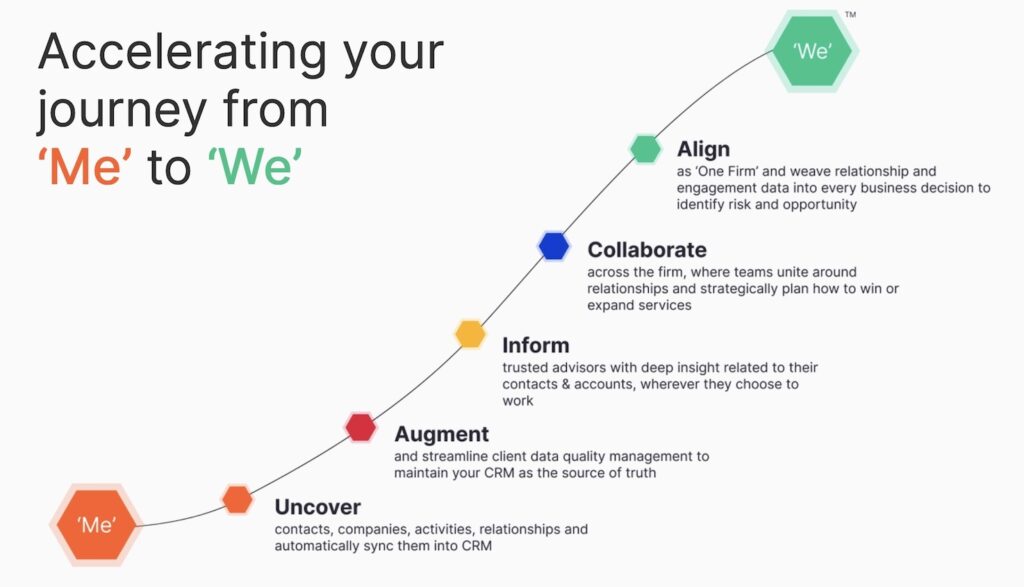In the complex world of professional services, maximizing and managing client relationships is critical for sustained business growth and success. It’s not enough for legal, accounting, and consulting firms to just hire talented contributors — they must utilize teamwork and effective collaboration to make the most of that talent and to improve their client relationships.
Take the example of a technology firm that retains an international trade lawyer to understand the legal and regulatory requirements of operating across borders. This retailer may offhandedly mention that it’s grappling with intellectual property challenges, posing a cross-selling opportunity. By managing the client relationship through collaboration, the international trade lawyer could work with another in-house intellectual property lawyer to increase service delivery, and generate revenue growth, underscoring the firm-wide benefits of effective collaboration.
In this blog, we’ll discuss what firms stand to lose by maintaining individualized relationships and explore the five steps to effectively managing client relationships through firm-wide client insights and collaboration.
The cost of siloed client relationships
Firms that work in silos and fail to collaborate by sharing contacts and relationships are exposed to significant risks. These organizations not only experience a lack of cross-selling opportunities — they may also see inconsistent service delivery, potential duplications of efforts, difficulties identifying clients’ needs, and missed opportunities to generate more revenue. A lack of collaboration can also hinder innovation among professional services firms, which has far-reaching business consequences.
To combat this fragmentation and leverage effective collaboration, many firms are moving away from viewing relationships as individually owned to institutionally owned. This helps to holistically understand clients’ needs and to put them at the center of decisions by ensuring robust and best-in-class service delivery. Putting clients at the forefront of decisions promotes trust and loyalty, which ultimately help to increase retention, referrals, and revenue growth.
Managing client relationships as One Firm
According to research from consulting group McKinsey & Company, organizations that have implemented a One Firm operating model — a model that emphasizes firm-wide coordination at every level of the business — are 2.3 times more likely to be in the top quartile of high-performing organizations.
To begin effectively managing client relationships and become One Firm, professional services organizations must develop robust client management processes. One means of achieving this is through cutting-edge client intelligence platforms like Introhive, which help firms navigate the five key steps toward becoming one unified firm.

Step #1: Uncover client insights
Organizations beginning their One Firm journey may experience several CRM and data issues. There may be poor adoption of CRM tools, requiring manual data entry and distracting fee earners away from billable activities. At the same time, senior professionals may hog clients’ contact information, leading to an incomplete and fragmented view of the firm’s fulsome client relationships. All of this means there is no single source of truth for client intelligence.
To tackle these problems, many professional services firms are leveraging client intelligence platforms like Introhive to uncover key contacts, relationships, and activities. This technology automatically and securely syncs client contacts and interactions into organizations’ CRM systems, helping fee earners reduce the time spent on manual data entry and upkeep. It also helps professionals across a firm understand who knows who — and who can facilitate a warm introduction — to help maximize collaboration and cross-selling opportunities.
Step #2: Augment CRM data management
With client data decaying at a rate of 70% per year, many firms are hiring dedicated individuals and teams to oversee data management and cleanup. This approach is both time-consuming and expensive. A deterioration in data quality is also unhelpful when it comes to corporate decision-making and may result in ineffective sales and marketing campaigns. All this prevents professionals from trusting data and existing CRM tools, creating a vicious cycle of poor user adoption and ongoing data challenges.
To augment and streamline the management of data quality, professional services firms can use client intelligence platforms. These types of technology help to maximize the value of firms’ CRMs by automatically maintaining and updating client records so that they are contextual and accurate. The continuous enrichment of client data boosts the effectiveness of marketing and business development efforts by ensuring they target the right leads and only those clients who represent the best fit for the firm. The automatic augmentation of client data also eliminates time-consuming and expensive data cleanup tasks and extensive data stewardship. This frees up time, allowing professionals to dedicate more hours to billable activities.
Step #3: Inform client advisors of insights
Organizations that are not yet operating as One Firm may find that limited visibility into their organizations’ client relationships leads to cross-business collisions, like doubling up on pitching the same client. At the same time, firms may have teams dedicated to gathering and synthesizing important client information to keep fee earners informed, which can be time-consuming and costly. Efforts to stay up-to-date on client milestones can often be spent on other important priorities. Moreover, when there’s limited visibility into the firm’s client relationships, it makes it difficult for fee earners to stay properly abreast of what’s happening with their clients, potentially resulting in a poor client experience and missed revenue opportunities.
To inform advisors with deep client insights, platforms like Introhive automatically provide fee earners with client information digests in their preferred workflows — such as Microsoft Teams, Outlook, or Calendar. These briefs help advisors anticipate client needs, offer timely advice, and deepen their client relationships by identifying potential new service opportunities. Automatic and digestible client briefs support professionals to demonstrate their commitment and expertise to clients, leading to more meaningful conversations and, ultimately, increased client loyalty and trust.
Step #4: Collaborate on client relationships internally
A lack of collaboration across firms’ practice groups can have detrimental effects and potentially result in missed revenue, cross-selling, and referral opportunities. Limited visibility into client relationship trends can also lead to poor business strategy, which can have far-reaching implications. For example, a client may fail to properly differentiate a firm’s service offerings from its competitors, resulting in a loss of competitive advantage and lower profit margins.
Client intelligence platforms can help firms strategically collaborate to accelerate referrals, cross-selling, and revenue opportunities, thereby supporting organizations on their journeys to becoming One Firm. Relationship intelligence software like Introhive also allows professional services advisors to leverage warm introductions and collaborate across practice groups to build holistic service delivery strategies that are consistent with clients’ needs. This ultimately helps to increase client win rates and revenue growth.
Step #5: Align your firm with a single view of client data
Before organizations strategically manage client relationships and become One Firm, they must align across teams. Firms can’t expand into existing accounts by cross-selling and upselling products or services unless they’ve effectively combined billing, client relationship data, and opportunity data. Those with a lack of alignment and insufficient insights may experience challenges when it comes to assessing client risk and opportunity, gauging client growth or contraction, and understanding all engagements of key accounts. Compounded with the lack of data needed for forecasting revenue, this can have a significant impact on business decision-making and direction.
Client intelligence software like Introhive supports organizations to align as One Firm and to implement both relationship and engagement data into every business process and decision. It also provides an objective view of organizations’ firm-wide relationships on a global scale, allowing professionals to analyze, segment, and visualize their contacts to help identify risks and opportunities. By effectively leveraging and managing client relationships, organizations can discover net new and cross-selling opportunities to boost revenue.
Why choose Introhive for client intelligence?
Introhive’s client intelligence platform empowers professional services firms with client relationship data to drive collaboration and revenue. Our software supports firm-wide alignment and helps to free up professionals’ time, as well as increase referrals, cross-selling, and new revenue opportunities. Request a demo to learn more.





